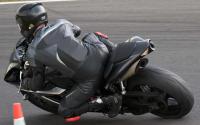New PC build: Asrock N100DC
- andypugh
-
 Topic Author
Topic Author
- Offline
- Moderator
-

Less
More
- Posts: 19752
- Thank you received: 4584
08 Jan 2025 21:45 #318470
by andypugh
New PC build: Asrock N100DC was created by andypugh
I decided that I was setting a bad example by running my own lathe on LinuxCNC 2.8.0~pre on Debian Wheezy. So I installed the latest LinuxCNC ISO on the DN2800MT that I built it with in 2015.
This consumed the entire 8GB SATA DOM SSD and was glacially slow. LinuxCNC and latency was fine, but UI response horrible, and I was having to press the cycle-start and (more worryingly) cycle stop buttons for a couple of seconds to get a response. Possibly a graphics issue, as Linux has never properly supported that chipset. It's also debatable whether it's a fully 64-but motherboard. (The specs and manual simply don't say...)
I could try playing about with graphics drivers and such. In fact I did, a bit, but then I got bored and bought a new motherboard.
Asrock N100DC www.mini-itx.com/~N100DC-ITX
The shopping list was:
PCIe slot (for the existing Mesa 6i25)
DC Power input ( to run off the controller 12V)
M2 SSD slot (so that there is no need to sort out SSD brackets, and to keep everything compact and low-power)
VGA connector (but it also has HDMI) so that my existing touchscreen (and touchscreen wiring, through the conduits and machine base) will work
Other possible plus points:
It has a parallel port header on the motherboard, in case you want to go old-school
It has a serial port, and a motherboard UART port too.
Latency is "fine". It runs at 11k most of the time, but can go up to 25k when opening web browsers, GLX gears, that sort of thing. Perfectly OK for a Mesa card. This is with an un-tweaked LinuxCNC 2.9.3 ISO install.
It's very snappy (possibly the SSD?) Touchy opens in under 2 seconds from pressing the button, and its 30 seconds from power-on to a responsive LinuxCNC GUI once autologin and autostart are set up. (and several seconds of that startup are spent waiting for grub to timeout and load the default).
I added an 8GB DIMM (the smallest DDR4 I could find) and a 240GB M2 SSD (again, the smallest and cheapest I could find)
Motherboard £106 + VAT
Memory £12.99
SSD £16.29
Total = £156
More than a Pi, but it will slot right in to the existing space.
This consumed the entire 8GB SATA DOM SSD and was glacially slow. LinuxCNC and latency was fine, but UI response horrible, and I was having to press the cycle-start and (more worryingly) cycle stop buttons for a couple of seconds to get a response. Possibly a graphics issue, as Linux has never properly supported that chipset. It's also debatable whether it's a fully 64-but motherboard. (The specs and manual simply don't say...)
I could try playing about with graphics drivers and such. In fact I did, a bit, but then I got bored and bought a new motherboard.
Asrock N100DC www.mini-itx.com/~N100DC-ITX
The shopping list was:
PCIe slot (for the existing Mesa 6i25)
DC Power input ( to run off the controller 12V)
M2 SSD slot (so that there is no need to sort out SSD brackets, and to keep everything compact and low-power)
VGA connector (but it also has HDMI) so that my existing touchscreen (and touchscreen wiring, through the conduits and machine base) will work
Other possible plus points:
It has a parallel port header on the motherboard, in case you want to go old-school
It has a serial port, and a motherboard UART port too.
Latency is "fine". It runs at 11k most of the time, but can go up to 25k when opening web browsers, GLX gears, that sort of thing. Perfectly OK for a Mesa card. This is with an un-tweaked LinuxCNC 2.9.3 ISO install.
It's very snappy (possibly the SSD?) Touchy opens in under 2 seconds from pressing the button, and its 30 seconds from power-on to a responsive LinuxCNC GUI once autologin and autostart are set up. (and several seconds of that startup are spent waiting for grub to timeout and load the default).
I added an 8GB DIMM (the smallest DDR4 I could find) and a 240GB M2 SSD (again, the smallest and cheapest I could find)
Motherboard £106 + VAT
Memory £12.99
SSD £16.29
Total = £156
More than a Pi, but it will slot right in to the existing space.
The following user(s) said Thank You: tommylight, rodw, tarasko, Cant do this anymore bye all
Please Log in or Create an account to join the conversation.
- Cant do this anymore bye all
-

- Offline
- Platinum Member
-

Less
More
- Posts: 1200
- Thank you received: 425
09 Jan 2025 01:48 #318488
by Cant do this anymore bye all
Replied by Cant do this anymore bye all on topic New PC build: Asrock N100DC
Some great info there.
Thanks Andy.
Thanks Andy.
Please Log in or Create an account to join the conversation.
- andypugh
-
 Topic Author
Topic Author
- Offline
- Moderator
-

Less
More
- Posts: 19752
- Thank you received: 4584
09 Jan 2025 11:45 - 09 Jan 2025 11:46 #318532
by andypugh
Replied by andypugh on topic New PC build: Asrock N100DC
In case anyone was excited by the motherboard UART header, apparently it's only accessible by the BIOS during boot, and is not available to the OS.
Last edit: 09 Jan 2025 11:46 by andypugh.
Please Log in or Create an account to join the conversation.
- tarasko
-

- Offline
- Senior Member
-

Less
More
- Posts: 61
- Thank you received: 3
30 Jul 2025 13:24 #332552
by tarasko
Replied by tarasko on topic New PC build: Asrock N100DC
Thanks. I'm looking to buy Asus Prime n100. How do you think will it have nice software step generation?
Please Log in or Create an account to join the conversation.
- andypugh
-
 Topic Author
Topic Author
- Offline
- Moderator
-

Less
More
- Posts: 19752
- Thank you received: 4584
30 Jul 2025 14:07 #332557
by andypugh
Replied by andypugh on topic New PC build: Asrock N100DC
It's hard to say without testing. There may be improvements to be made with isolcpus and other tweaks too.
If the board you get matches the one have with 25k latency then you should be able to step at about 5kHz (theoretical is max is 40kHz with a 25k base thread, but the differences in motor speed between every 5th cycle and every 4th and so on are more than the motor will follow)
With 4x microstepping 5kHz is about 375rpm at the motor shaft. Or 1800mm/min with a 5mm pitch screw..
You might want to start with software stepping / parport to get going, but it's not the best solution. If you are using a paralle port already then a Mesa 7i90 can be used to massively increase step rate and smoothness, and it adds a lot more IO too. There are other options from Mesa too, as well as from Pico systems and you can also look at the alternative firmwares like Remora for alternative hardware.
If the board you get matches the one have with 25k latency then you should be able to step at about 5kHz (theoretical is max is 40kHz with a 25k base thread, but the differences in motor speed between every 5th cycle and every 4th and so on are more than the motor will follow)
With 4x microstepping 5kHz is about 375rpm at the motor shaft. Or 1800mm/min with a 5mm pitch screw..
You might want to start with software stepping / parport to get going, but it's not the best solution. If you are using a paralle port already then a Mesa 7i90 can be used to massively increase step rate and smoothness, and it adds a lot more IO too. There are other options from Mesa too, as well as from Pico systems and you can also look at the alternative firmwares like Remora for alternative hardware.
The following user(s) said Thank You: tarasko
Please Log in or Create an account to join the conversation.
- tarasko
-

- Offline
- Senior Member
-

Less
More
- Posts: 61
- Thank you received: 3
04 Aug 2025 14:24 - 04 Aug 2025 14:44 #332822
by tarasko
Replied by tarasko on topic New PC build: Asrock N100DC
Hello. I've build a setup with ASUS prime N100I-D D4
Turned off some CPU related features in BIOS and added
to linux kernel cmdline params
"isolcpus=2,3 acpi_irq_nobalance noirqbalance"
So Max Jitter(ns) for Base thread is 29725.
Any other optimizations which I've forget about?
Turned off some CPU related features in BIOS and added
to linux kernel cmdline params
"isolcpus=2,3 acpi_irq_nobalance noirqbalance"
So Max Jitter(ns) for Base thread is 29725.
Any other optimizations which I've forget about?
Last edit: 04 Aug 2025 14:44 by tarasko.
Please Log in or Create an account to join the conversation.
- andypugh
-
 Topic Author
Topic Author
- Offline
- Moderator
-

Less
More
- Posts: 19752
- Thank you received: 4584
08 Aug 2025 20:23 #333067
by andypugh
Replied by andypugh on topic New PC build: Asrock N100DC
I think that's about as good as it gets, and it's perfectly usable for most purposes (especially if you don't plan on using software step generation or encoder counting)
Please Log in or Create an account to join the conversation.
- rodw
-

- Offline
- Platinum Member
-

Less
More
- Posts: 11566
- Thank you received: 3884
09 Aug 2025 12:20 #333117
by rodw
Replied by rodw on topic New PC build: Asrock N100DC
if Mesa or ethercat, disable energy efficient Ethernet with commands for your NIC (Intel/Realtek) and consider adjusting IRQ for the network card to prefer the core the servo thread is running one. There is a script somewhere on the forum here.
Please Log in or Create an account to join the conversation.
Time to create page: 0.087 seconds
